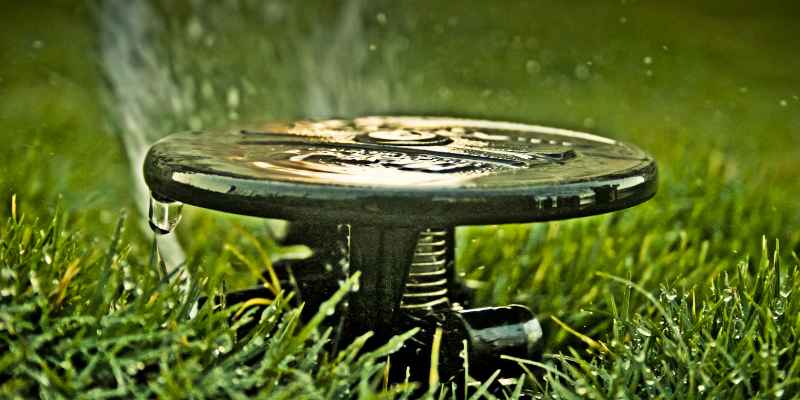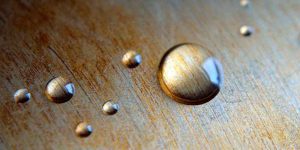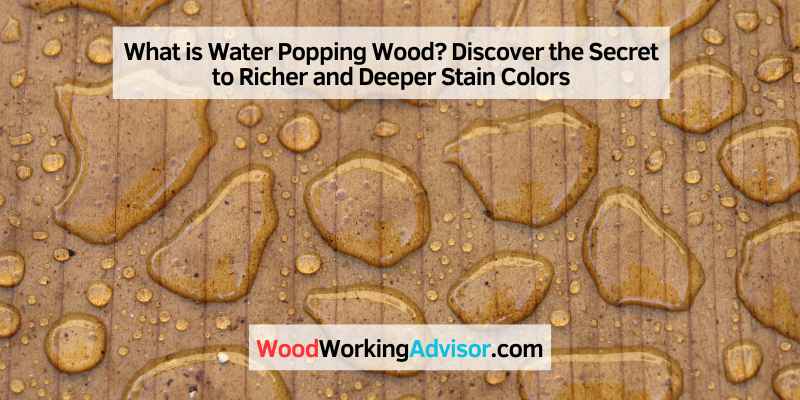Water popping wood is a process of opening the grain in wood flooring by adding water, before staining. This helps achieve a richer appearance in the stain.
Water popping is a technique used in woodworking to enhance the appearance of wood flooring by preparing the surface for staining. By introducing water to the sanded wood surface before applying the stain and finish, this process helps to open the wood grain, resulting in a more even and luxurious finish.
Understanding the ins and outs of water popping can make a significant difference in the final look of your wood projects, providing a more consistent and aesthetically pleasing result. Let’s delve deeper into the world of water popping wood and explore its benefits and techniques.
Exploring Water Popping Wood
Water popping wood is a technique that involves adding water to the surface of unfinished wood to open up the smooth and closed wood grain. This process helps to achieve a more even and rich appearance in the stain, creating a darker and more uniform color.
It is a crucial step before applying the stain and finish to the wood.
What Is Water Popping?
Water popping is a process that opens the grain in wood flooring to achieve a more even and rich appearance in the stain. It involves adding water to the wood floor after sanding but before applying the stain and finish.
How Does Water Popping Work?
Water popping works by introducing clean water to an unfinished wood surface, which helps open or “pop” the smooth and closed wood grain. As wood absorbs water, the wood cells expand, creating a more open surface for staining.
The Pros And Cons Of Water Popping
- Pros:
- Creates a more even and rich appearance in the stain
- Helps reduce contrast between hard and soft grain areas
- Enhances the overall finish of the wood flooring
- Cons:
- Requires careful and strategic application of water
- Additional step in the wood finishing process
- May not be necessary for all wood flooring projects
Water popping is a technique that can enhance the aesthetic quality of wood flooring by providing a deeper and more uniform coloration. Understanding the process and benefits of water popping can help achieve desired results in wood finishing projects.
Understanding The Process
Water popping is a technique used to enhance the appearance of wood flooring before applying a finish. By adding water to the sanded wood, the grain is opened to allow for a more even and rich stain application. This process results in a deeper and more vibrant finish, creating a visually appealing surface.
When And Why To Use Water Popping
Water popping is a technique used in the wood finishing process to achieve a richer and more even color on the wood surface. It involves adding water to the wood after it has been sanded, which opens up the grain of the wood and allows the stain to penetrate more deeply. This results in a darker and more saturated color, with less contrast between the hard and soft grain areas.
Water Popping Vs. Traditional Staining
When compared to traditional staining methods, water popping offers several advantages. Firstly, it helps to eliminate blotchiness and uneven color penetration that can sometimes occur when staining wood. By opening up the grain, water popping ensures that the stain is absorbed more uniformly, resulting in a more consistent and attractive finish.
Additionally, water popping can enhance the overall appearance of the wood by highlighting the natural grain patterns and adding depth to the color. This technique is particularly beneficial when working with woods that have a tight or closed grain structure, as it allows the stain to penetrate more effectively.
While water popping can be a time-consuming step in the wood finishing process, the end result is often well worth the effort. It provides a more professional and polished finish, making it a popular choice for both DIY enthusiasts and professional woodworkers.
In conclusion, water popping is a valuable technique to consider when aiming to achieve a darker and more even stain on wood surfaces. By understanding the process and knowing when and why to use water popping, you can achieve stunning results on your wood projects.
Implementing Water Popping
Water popping, also known as grain-popping, is a simple technique that can enhance the appearance of wood flooring by creating a richer, deeper color. This process involves introducing clean water to the surface of the wood, which opens up the grain and allows for better absorption of stains and finishes. By implementing water popping, you can achieve a more even and consistent color throughout the wood.
Preparation Steps
Before you begin the water popping process, it is important to properly prepare the wood surface. Follow these steps:
- Clean the surface: Remove any dust, dirt, or debris from the wood by using a broom or vacuum cleaner.
- Sand the wood: Use a sanding machine or sandpaper to smooth out the surface and ensure an even texture.
- Remove excess dust: Wipe down the wood with a damp cloth or tack cloth to eliminate any lingering dust particles.
Water Popping Techniques
There are several techniques you can use to water pop wood flooring. Here are two commonly used methods:
Method 1: Spraying on Water
One technique involves spraying water onto the wood surface. Follow these steps:
- Fill a spray bottle with clean water.
- Evenly spray a fine mist of water onto the wood, making sure to cover the entire surface.
- Allow the water to sit on the wood for approximately 10-15 minutes to fully open up the grain.
Method 2: Using a T-bar
Another method involves using a T-bar applicator to apply water onto the wood. Follow these steps:
- Dampen the T-bar applicator with clean water.
- Spread the water evenly across the wood surface using the T-bar, making sure to cover all areas.
- Allow the water to penetrate the wood for about 10-15 minutes.
Common Mistakes To Avoid
While water popping can be a beneficial technique, there are some common mistakes that should be avoided. These include:
- Applying too much water, which can cause the wood to become oversaturated and may lead to warping or other damage.
- Using dirty water that contains impurities, which can create uneven results or cause stains on the wood.
- Not allowing enough time for the water to penetrate the wood, resulting in inadequate grain opening.
- Skipping the proper preparation steps, such as cleaning and sanding, which can affect the overall outcome.
By following the proper techniques and avoiding these common mistakes, you can successfully implement water popping to achieve a beautiful and consistent finish on your wood flooring.
Achieving Desired Results
Water popping wood is a crucial step in achieving desired results when staining and finishing wood surfaces. This technique involves introducing clean water to the wood to open up the grain, allowing for a more even and rich appearance in the final stain.
Impact On Stain Colors
Using water popping enhances the saturation of the wood floor stain, resulting in darker and more uniform colors across the surface. This technique reduces the contrast between the hard and soft grain areas, providing a more consistent and aesthetically pleasing finish.
Effect On Wood Grain
Water popping helps open up the smooth and closed wood grain by expanding the wood cells when water is introduced. As the water evaporates, the expanded cells remain open, allowing for better penetration of the stain and a smoother overall finish.
Sanding After Water Popping
Sanding after water popping is not recommended as it would close the grain back down, negating the benefits of water popping. Avoid sanding the wood after water popping to maintain the opened grain structure for optimal stain absorption and a refined final look.
Professional Insights

Expert Recommendations
Water popping enhances the richness and depth of wood stains.
When water-popping, apply a generous amount of water evenly.
Ensure the wood floor is sanded before initiating the water-popping process.
Real-life Experiences
Professionals attest to the effectiveness of water-popping for achieving an even and rich finish.
Woodworkers emphasize the importance of precision and care in the water-popping technique.
Real-life examples showcase the transformative impact of water-popping on wood flooring.
Advanced Applications
Water popping is a technique where water is added to wood flooring after sanding to enhance the wood’s appearance before applying stain and finish. This process opens the wood grain, creating a richer and more even color for a professional-looking finish.
Utilizing Water Popping For Difficult Stains
Water popping is not only a technique used to enhance the appearance of wood flooring, but it can also be a practical solution for tackling difficult stains. When traditional stain application methods fail to produce the desired results, water popping can be a game changer.
By opening up the grain of the wood, water popping allows the stain to penetrate deeper, resulting in a more even and rich color. This technique is particularly effective when dealing with stubborn stains, such as ink or pet urine, that may have seeped deep into the wood.
Innovative Approaches
Aside from its stain-enhancing capabilities, water popping can also be used in innovative ways to achieve unique and artistic effects on wood flooring. Here are a few examples:
- Color Blending: By adjusting the amount of water applied during the water popping process, it is possible to create beautiful color gradients on the wood surface. This technique can be used to blend different shades of stain or create a stunning ombre effect.
- Custom Designs: Water popping can be a valuable tool for creating intricate designs on wood flooring. By strategically applying water in specific patterns or shapes, you can achieve visually stunning effects that will make your floor truly one-of-a-kind.
- Artistic Effects: Want to add a touch of artistic flair to your wood flooring? Water popping can be used to create unique textures and patterns that mimic the look of natural wood grain. From distressed finishes to faux wood effects, the possibilities are endless.
With the versatility of water popping, the only limit is your imagination. Whether you need to remove a stubborn stain or want to add a creative touch to your wood flooring, this technique opens doors to advanced applications that can transform your space.
Industry Perspectives
Water popping is a process that involves adding water to a wood floor after it has been sanded down but before applying the stain and finish. This helps to open the grain and achieve a more even and rich appearance in the stain, resulting in a darker and more consistent color on each board.
It is a simple step that can enhance the overall look of the wood flooring.
Water Popping Techniques In The Flooring Industry
Water popping is a crucial step in the flooring industry that enhances the appearance and overall finish of hardwood floors. This technique involves introducing clean water to the surface of unfinished wood to open up the wood grain, providing a more consistent and richer color when staining.
Widespread Adoption And Benefits
Across the flooring industry, water popping has seen widespread adoption due to its numerous benefits. By opening up the wood grain through this technique, stains are absorbed more evenly, resulting in a smoother finish with reduced contrast between grain areas.
- Enhanced Appearance: Achieve a more even and rich appearance in the stain.
- Consistent Color: Promotes a consistent and uniform color across the wood surface.
- Smooth Finish: Helps in creating a smoother finish by preparing the wood for staining.
Water popping brings about a transformative effect on wood flooring, providing a foundation for achieving high-quality results in the staining and finishing process.
Conclusion And Considerations
Water popping is a technique used to open the grain in wood flooring before applying stain and finish. By adding water to the wood, the grain is “popped,” resulting in a more even and rich appearance. This process ensures a darker and more consistent color on each board, with less contrast between hard and soft grain areas.
Water popping is a valuable technique in the world of woodworking, offering a simple yet effective method to achieve a richer and more even appearance in wood floor staining. By opening up the grain of the wood, water popping allows for increased saturation of the stain, resulting in darker and more consistent color across each board. It also helps to minimize contrast between the hard and soft grain areas.
Best Practices For Water Popping
If you decide to incorporate water popping into your wood flooring project, here are some best practices to keep in mind:
- Start in a predetermined area and work towards an exit point
- Ensure the wood surface is clean and free from debris before applying water
- Apply water to the wood using a spray bottle or rag
- Allow the water to penetrate the wood for a few minutes
- Wipe away any excess water after the desired soaking time
- Allow the wood to dry completely before continuing with the staining and finishing process
It’s important to note that water popping may not always be necessary. If you prefer a natural stain color or desire more contrast between the hard and soft grain areas, skipping the water popping step is perfectly acceptable.
In conclusion, water popping is a versatile technique that can greatly enhance the overall appearance of wood flooring. By following the best practices outlined above, you can achieve stunning and consistent results in your wood staining projects.

Frequently Asked Questions On What Is Water Popping Wood
Does Water Popping Make Stain Darker?
Water-popping makes the wood stain darker and creates a richer, even color on the floor. It reduces contrast between hard and soft grain areas, resulting in a more uniform appearance. If you want natural color reflection and more grain contrast, water-popping isn’t necessary.
Should I Sand After Water Popping?
No, sanding after water popping defeats the purpose of water popping. It would remove the opened grain and result in a closed grain again.
What Is Popping Water?
Water popping is a process that opens the wood grain for a richer, even stain application.
What Is Water Popping And How Does It Work?
Water popping is a process that involves adding water to unfinished wood flooring before applying stain and finish. By opening the wood grain, water popping creates a more even and rich appearance in the stain, resulting in a darker and more uniform color on each board.
Conclusion
Enhance the beauty of your wood floors with water popping for a richer and deeper hue. By opening the grain through this method, you create a more uniform and appealing finish. Water popping is a crucial step in achieving a professional look for your hardwood floors.
Unlock the potential of your wood surfaces with this technique.


